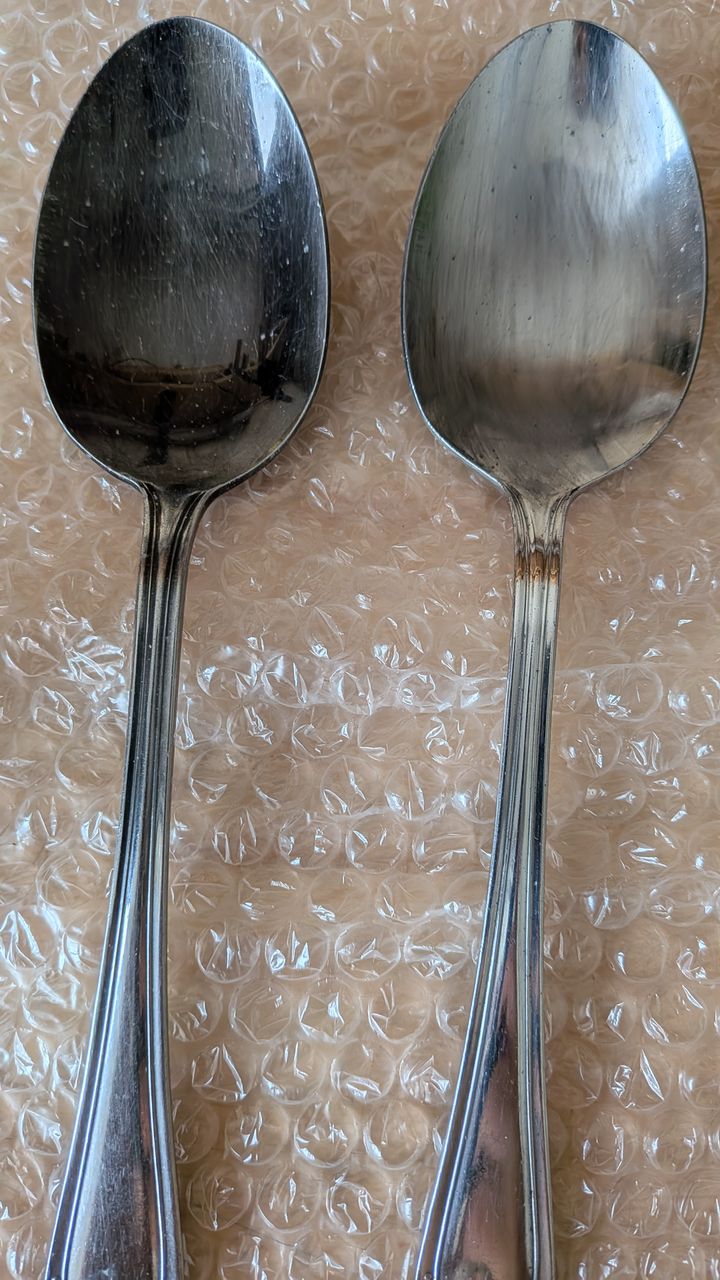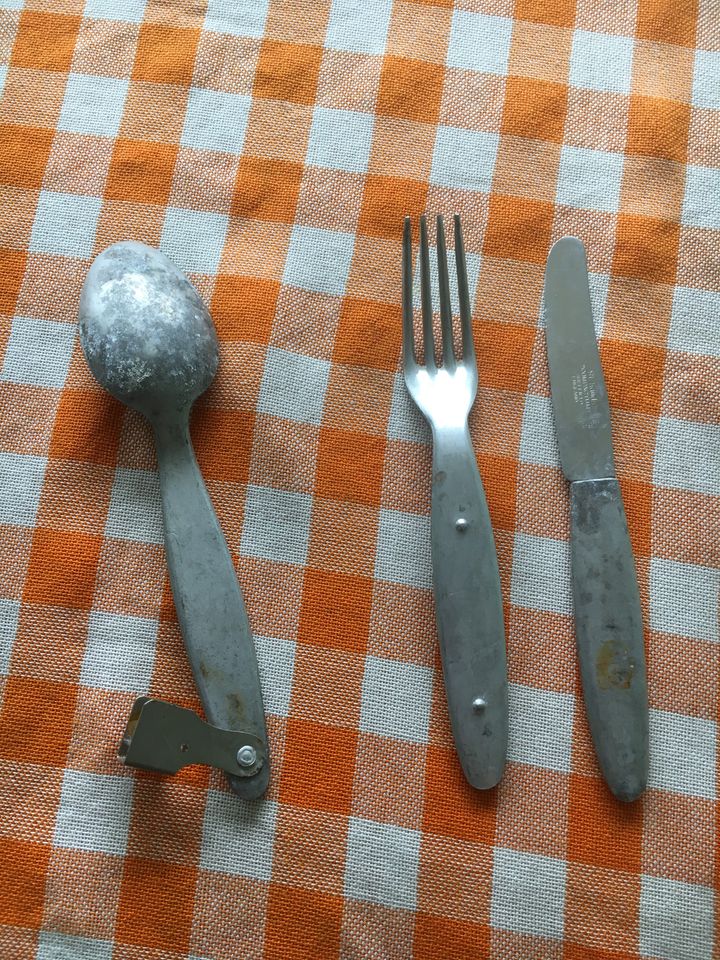Stainless cutlery - aggressive cleaning
Discussion
I obtained some stainless cutlery that matches the make and design I already have. It looks to have been used over a BBQ or something similar because it has a black coating on it which is very difficult to remove
I have a bench polisher which worked perfectly for the knives and forks (took a lot of work) but the inside radius of the spoons is too tight for the polisher wheels to fit into.
I wondered if there was a chemical which would eat the black coating off the stainless steel but leave the bare metal alone?.. or any other suggestions?
The pic below shows one spoon with the coating removed using 1200 grit sandpaper. This isn't a viable solution for the rest of the cutlery though because I can't polish-out the scratches.

I have a bench polisher which worked perfectly for the knives and forks (took a lot of work) but the inside radius of the spoons is too tight for the polisher wheels to fit into.
I wondered if there was a chemical which would eat the black coating off the stainless steel but leave the bare metal alone?.. or any other suggestions?
The pic below shows one spoon with the coating removed using 1200 grit sandpaper. This isn't a viable solution for the rest of the cutlery though because I can't polish-out the scratches.
I use Steradent tables, great for cutlery and cleaning tea stains out of cups.
https://www.sainsburys.co.uk/gol-ui/product/sterad...
https://www.sainsburys.co.uk/gol-ui/product/sterad...
Mars said:
I have a bench polisher which worked perfectly for the knives and forks (took a lot of work) but the inside radius of the spoons is too tight for the polisher wheels to fit into.
Dremel with some sort of polishing device? Mars said:
I wondered if there was a chemical which would eat the black coating off the stainless steel but leave the bare metal alone?.. or any other suggestions?
The pic below shows one spoon with the coating removed using 1200 grit sandpaper. This isn't a viable solution for the rest of the cutlery though because I can't polish-out the scratches.
I can't think of a chemical, though I'm sure there is one - but re scratches you can go from 1200 grip to shiny. Wet/dry paper goes up to at least 3,000 and from there, metal polish.The pic below shows one spoon with the coating removed using 1200 grit sandpaper. This isn't a viable solution for the rest of the cutlery though because I can't polish-out the scratches.
GAjon said:
If you’ve any stainless steel fabrication workshops nearby, see if they’ll sell you a small amount of pickling paste.
It’s nasty stuff though, hydroflouric and nitric acid.
Failing that try autosol a soft cloth and elbow grease.
Just an nitric acid dip would get it done - can buy the nitric acid online cheaply. Don't want to do it too often but once to restore the natural colour would be OK.It’s nasty stuff though, hydroflouric and nitric acid.
Failing that try autosol a soft cloth and elbow grease.
Although before that I'd try simmering them in one part vinegar, 4 parts water in a stainless pan for an hour or so. It's common technique to rescue heat stained stainless pans and can be achieved using household stuff so it's a sensible and harmless first attempt. If nothing else, you'll get a lovely shiny pan afterwards

(open the windows though, boiling vinegar makes for a poor home fragrance)
GAjon said:
If you’ve any stainless steel fabrication workshops nearby, see if they’ll sell you a small amount of pickling paste.
It’s nasty stuff though, hydroflouric and nitric acid.
Failing that try autosol a soft cloth and elbow grease.
Don't ever get hydroflouric acid on your skinIt’s nasty stuff though, hydroflouric and nitric acid.
Failing that try autosol a soft cloth and elbow grease.
The first thing you'll know about it is a sometime later when it crumbles the bone
spikeyhead said:
GAjon said:
If you’ve any stainless steel fabrication workshops nearby, see if they’ll sell you a small amount of pickling paste.
It’s nasty stuff though, hydroflouric and nitric acid.
Failing that try autosol a soft cloth and elbow grease.
Don't ever get hydroflouric acid on your skinIt’s nasty stuff though, hydroflouric and nitric acid.
Failing that try autosol a soft cloth and elbow grease.
The first thing you'll know about it is a sometime later when it crumbles the bone
A hand sized area is enough to take the calcium from your bones, and dump it into your blood stream, causing cardiac arrest.
That's still just a polish and it won't passivate the exposed surface.
Stick it into some hot citric acid and it should do the trick, it's used as the much friendlier alternative to nitric in a lot of modern stainless processing.
It should remove the tarnish and help prevent it in future by removing any exposed iron and leaving a surface of just the corrosion resistant elements.
Stick it into some hot citric acid and it should do the trick, it's used as the much friendlier alternative to nitric in a lot of modern stainless processing.
It should remove the tarnish and help prevent it in future by removing any exposed iron and leaving a surface of just the corrosion resistant elements.
On a similar subject, and not wanting to start a separate thread for it, I recently found this cutlery set which appears to be aluminium or similar light metal:

Can I use any of the above to remove the marks from it? I've tried warm soapy water and a bit of a non-stick friendly scouring pad. I have citric acid but I'm not sure it's so good when it's not steel. I haven't tried scraping because of the same issue, not wanting to put in marks that I then can't get out.
Can I use any of the above to remove the marks from it? I've tried warm soapy water and a bit of a non-stick friendly scouring pad. I have citric acid but I'm not sure it's so good when it's not steel. I haven't tried scraping because of the same issue, not wanting to put in marks that I then can't get out.
droopsnoot said:
On a similar subject, and not wanting to start a separate thread for it, I recently found this cutlery set which appears to be aluminium or similar light metal:

Can I use any of the above to remove the marks from it? I've tried warm soapy water and a bit of a non-stick friendly scouring pad. I have citric acid but I'm not sure it's so good when it's not steel. I haven't tried scraping because of the same issue, not wanting to put in marks that I then can't get out.
Pretty sure that's aluminium. A few things can strip the oxide; oxalic acid is a popular one for fixing polished aluminium surfaces so should be effective, other stuff like ammonia will do it too.Can I use any of the above to remove the marks from it? I've tried warm soapy water and a bit of a non-stick friendly scouring pad. I have citric acid but I'm not sure it's so good when it's not steel. I haven't tried scraping because of the same issue, not wanting to put in marks that I then can't get out.
Just be careful with it, don't leave it soaking. Also be careful of the steel bits.
Old toothbrush usually works for loosening deposits after theyve dissolved a bit.
Edited by JoshSm on Thursday 21st August 09:12
droopsnoot said:
On a similar subject, and not wanting to start a separate thread for it, I recently found this cutlery set which appears to be aluminium or similar light metal:

Can I use any of the above to remove the marks from it? I've tried warm soapy water and a bit of a non-stick friendly scouring pad. I have citric acid but I'm not sure it's so good when it's not steel. I haven't tried scraping because of the same issue, not wanting to put in marks that I then can't get out.
Citric acid or just plain vinegar in a 1-4 mix and heated to a simmer will work for aluminium as it will for stainless - just faster. However, is it worth it? Aluminium will inevitably mist over again as it wants to form a thin oxidised layer.Can I use any of the above to remove the marks from it? I've tried warm soapy water and a bit of a non-stick friendly scouring pad. I have citric acid but I'm not sure it's so good when it's not steel. I haven't tried scraping because of the same issue, not wanting to put in marks that I then can't get out.
Also what's the handle of the knife made of? It's not clear if that's also aluminium or something else which may not respond well to acidic cleaning.
droopsnoot said:
On a similar subject, and not wanting to start a separate thread for it, I recently found this cutlery set which appears to be aluminium or similar light metal:

Can I use any of the above to remove the marks from it? I've tried warm soapy water and a bit of a non-stick friendly scouring pad. I have citric acid but I'm not sure it's so good when it's not steel. I haven't tried scraping because of the same issue, not wanting to put in marks that I then can't get out.
Check this out as could be worth doing it properly?Can I use any of the above to remove the marks from it? I've tried warm soapy water and a bit of a non-stick friendly scouring pad. I have citric acid but I'm not sure it's so good when it's not steel. I haven't tried scraping because of the same issue, not wanting to put in marks that I then can't get out.
https://www.militariazone.com/general-other/ww2-br...
dickymint said:
Check this out as could be worth doing it properly?
https://www.militariazone.com/general-other/ww2-br...
I love that they list that as 'over 18's only', when the knife looks like the sort of thing they would happily give a child to eat their school dinner https://www.militariazone.com/general-other/ww2-br...

Gassing Station | Homes, Gardens and DIY | Top of Page | What's New | My Stuff



